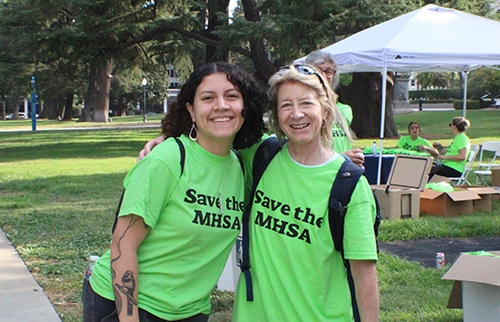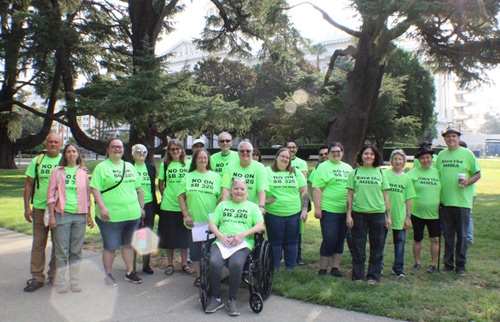2023 Annual Report - Peer Self-Advocacy

2023 Annual Report - Peer Self-Advocacy
Advocacy Victories Peer Self-Advocacy
Advocacy Victories Peer Self-Advocacy
Celebrating the 21st Anniversary of the California Memorial Project
The California Memorial Project (CMP) recognizes the third Monday in September as an annual day of remembrance with ceremonies across the state. The ceremonies honor those who lived and died in state hospitals and developmental centers between the mid-1800’s to mid-1900’s, as well as those who currently live in state institutions. The remembrance ceremonies are a yearly time to reflect on the lives of those who were lost and those who are often forgotten.
This year was the first year since the beginning of the pandemic that in-person ceremonies were once again held at various state hospital and developmental center sites and local cemeteries where residents were buried. Over 200 people attended the in-person ceremonies honoring individuals from Napa State Hospital, Metropolitan State Hospital, Modesto State Hospital and Stockton Developmental Center. There was also a virtual ceremony, which gave an opportunity for people in the community to participate who were not able to travel.
Some of the ceremonies included guest speakers with personal experience living in an institution, artwork, music and poems from current state hospital residents and disabled artists, and a virtual tour of the history and artifacts from Patton State Hospital’s museum. Each year, the CMP also holds a moment of silence across the state to remember and honor the lives of our peers.
With these ceremonies, we highlight the stigma and discrimination faced by those with disabilities. We also seek to educate the public about the importance of voluntary, community-based treatment options that are more effective than the forced treatment our peers received. With recent California legislation that will serve to institutionalize more people with mental health disabilities, it is even more critical that people understand there are alternatives to involuntary hospitalization that honor and respect the rights and dignity of our peers.
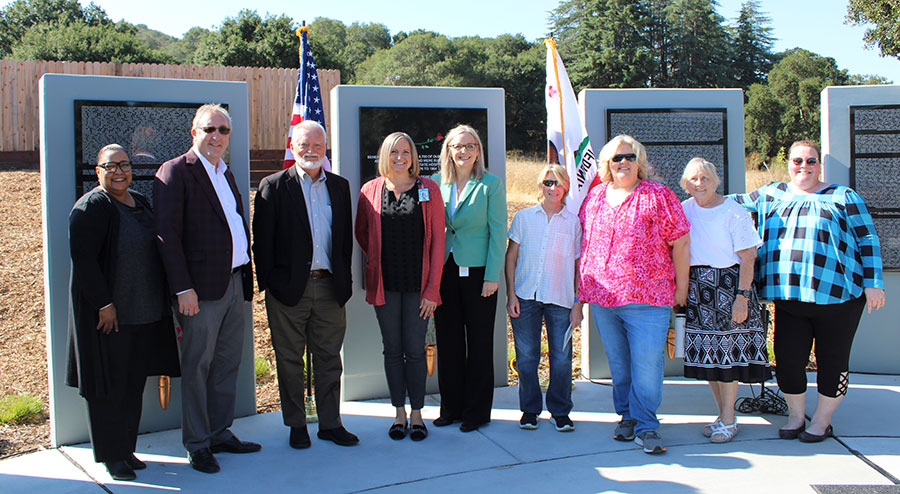 Left to right: DRC staff members Leslie Napper and Andy Imparato, former State Senator Wesley Chesbro, Executive Director DSH-Napa Jennie Clay, Director of the California Department of State Hospitals Stephanie Clendenin and DRC staff Robyn Gantsweg, Beth Tobin, Debi Davis, and Jode Keasler gathered in front of the Napa State Hospital memorial site.
Left to right: DRC staff members Leslie Napper and Andy Imparato, former State Senator Wesley Chesbro, Executive Director DSH-Napa Jennie Clay, Director of the California Department of State Hospitals Stephanie Clendenin and DRC staff Robyn Gantsweg, Beth Tobin, Debi Davis, and Jode Keasler gathered in front of the Napa State Hospital memorial site.
This year, a monument dedicated to the lives of over 8,000 people who died at Napa State Hospital was unveiled during Napa’s remembrance ceremony. The monument is the first of its kind to include the full names of those who died between 1876 and 1964 and were buried in unmarked graves.
The Napa memorial has been a multi-decade effort that involved hand-reviewing former state hospital ledgers and decoding descriptions of those who were unnamed when they died. The monument serves as a model for future memorials at other state hospital and former developmental center sites across California.
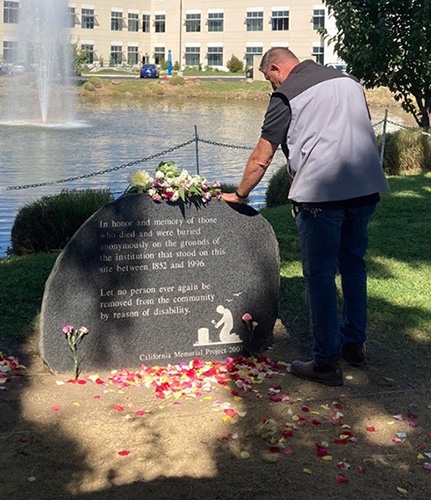 Chuck Meyers, Manager of Operations for Grupe Huber Company, honors individuals who passed away at Stockton Developmental Center.
Chuck Meyers, Manager of Operations for Grupe Huber Company, honors individuals who passed away at Stockton Developmental Center.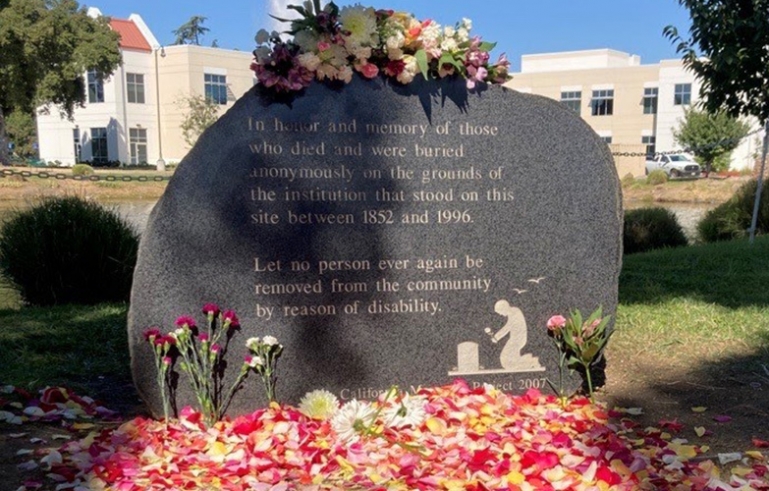 Flower petals adorn the CSU-Stanislaus Campus monument in honor of people who lived and died at Stockton Developmental Center.
Flower petals adorn the CSU-Stanislaus Campus monument in honor of people who lived and died at Stockton Developmental Center.Peer Advocates Working Together in Solidarity
PSA staff worked with members of Peers Advocating for Rights and Recovery (PARR), a coalition of representatives from peer-run organizations and individual peer advocates, to coordinate a gathering of peers at the Assembly Health committee hearing on Senate Bill 326 in August. They attended the hearing and advocated as a group to demonstrate their community’s opposition to the bill. The bill would drastically reduce funding for current mental health services, affecting the entire peer community. Members of PARR and other peers in the community, some of whom do not live in Sacramento, traveled to the Capitol to attend the hearing.
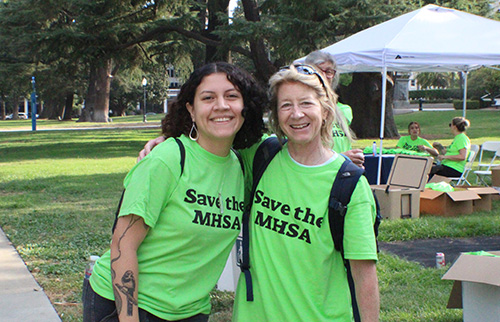 Robyn Gantsweg and D. Harvey from DRC's Peer Self-advocacy Program.
Robyn Gantsweg and D. Harvey from DRC's Peer Self-advocacy Program.
During the public comment period, peers voiced their strong opposition to the legislation. While most of the legislators supported SB 326, some expressed concerns about the potential effects and effectiveness of this proposed legislation and decided to oppose or abstain from voting for the bill. In a previous hearing, the vote was unanimous in support of the bill. The peer group’s collective advocacy seemed to make an impact on the assembly members’ votes, showing that their collaboration can make a difference.
Self-Advocacy in Action
PSA staff presented a training on Self-Advocacy: How to Create Your Own Action Plan to self-advocacy group members at a state hospital. One group member was hard of hearing and mentioned they needed help getting hearing aids. They didn’t know the process for requesting them. The PSA staff member and the resident worked together to create an action plan the resident could use as a tool to get hearing aids.
In developing the action plan, they identified they would first need to speak with their medical doctor. With the help of the rehabilitation therapist, the group member was able to make an appointment to see the doctor. The doctor gave them a referral for a hearing specialist. Two weeks went by, and they had not seen the specialist. Having learned from the Action Plan training that they might run into obstacles, they adapted their action plan and followed up with the doctor and social worker.
They finally got an appointment with the hearing specialist. As a result of their self-advocacy, the group member was happy to share they would receive the hearing aids in a few weeks. This is a good example of self-advocacy in action.

